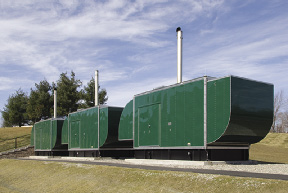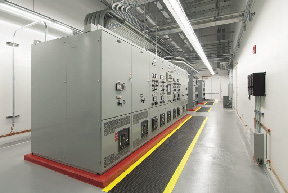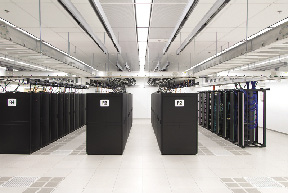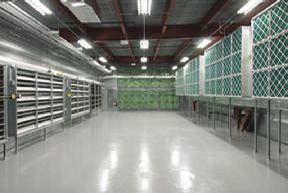The Obama administration has made available $975 million in grants which will help states, doctors and hospitals move from paper to electronic record-keeping - spurred on by studies showing that electronic medical records help reduce medical errors and improve the quality of patient care. The grant money comes from the economic stimulus package passed by Congress last year and is part of the National Healthcare Act's push to get health care providers to adopt 21st century electronic record technology.
What most people are not aware of is that transmission of information, such as MRIs and X-rays and other electronically robust documents, between all relevant health care entities - doctors, hospitals, research institutions, etc. - entails substantially more bandwidth and data storage capacity than simple medical forms do. This is why the issue of medical data storage - both the building of new data centers and the retrofitting or expansion of older ones to handle more sophisticated and increased amounts of data - has become more critical than ever.
In response to this important new demand, Tishman Construction Corp. is currently working on two projects involving medical data centers in the Boston area, one for the University of Mass. Medical School (UMMS), and the other for the Children's Hospital Boston.Its work on these two projects illustrates trends not just in medical data center construction and retrofitting, but the unique challenges that such projects offer.
Deployable Technology and Monetary Incentives for Healthcare IT Are Available
Ron Bowman, executive vice president of Tishman Technologies and a recognized expert in mission critical data centers and green energy said, "Undoubtedly, a data center is a major undertaking, but the decision to build or retrofit new medical data storage centers could not occur at a better time than the present. Now is the time to make technology and infrastructure improvements - everything from facilities' survivability with cogeneration and hydrogen fuel cell enhancements to billing and call center IT improvements - because now we have commercially deployable technology that's simple, scalable, affordable, and burstable. Additionally, we have the incentives provided by funds slated for healthcare IT by the Obama administration and the American Recovery and Reinvestment Act (ARRA)."
Some of the complex challenges facing companies, hospitals and schools considering whether to build or retrofit existing medical data storage centers are disturbances in power supply, voltage surges and other abnormalities, as well as construction of a facility that must support a complex network of technology systems that extend from the data center to the patient bedside. Health care facilities are now presented with a greater need to have more control over IT infrastructure in order to assure the continuous operation of technology systems, while scaling the size of the facilities to support continued growth in server and storage capacity and changing new technologies and methods. Continuous power supply and proper cooling systems are, of course, critical components of a successful medical data storage center.
"Our technologies and construction professionals have been heavily involved in the data center sector for over 20 years and are familiar with all the aspects of these mission-critical facilities," said Tom Erickson, Tishman Construction's senior vice president in charge of its New England operations.
UMass Facility Will Expand Capacity While Paying Attention to Conserving Energy
Tishman project at the University of Mass. Medical School (UMMS) comprises a new data center and supporting infrastructure. The new energy-efficient data center will provide scalable, secure and redundant storage capabilities for UMMS's current and future critical data requirements and will utilize new technologies, such as flywheel-backed UPS systems and air-side economizing. In addition, by removing all HVAC components from the data center box while providing complete system monitoring, the owners can essentially "turn off the lights". Tishman has been hired to serve as construction manager for this $15 million project, and has provided comprehensive planning and pre-construction services leading up to the start of construction.
Martin O'Neill, vice president, Tishman, said that UMMS is leading the way technologically, by example. "Data center users are doing more with less," he said. "Institutions are using new and innovative methods of cooling delivery systems including fan wall systems. UMMS has also implemented flywheel support to the UPS (Uninterrupted Power Supply) systems in lieu of more commonly used battery backup, which ultimately use less energy and reduce the PUE (power usage effectiveness) of the project."
Children's Hospital Data Center Undergoes Renovations and Utility Upgrade
In addition to its work for UMMS, Tishman is also providing construction management services to Children's Hospital Boston, for major renovations and utility upgrades to its main 12,000 s/f data center. The work includes upgrades to the UPS system, replacing chilled-water cooling pumps, relocating existing Liebert units, and interior office renovations. The main challenge of this project is working within a live data center that supports the Boston hospital's operations.
In 2009, Tishman provided Children's with construction advice, cost estimates, and schedules for a study for a new "state-of-the-art" data center outside of Boston. The 8,300 s/f data center and support space are being contemplated to retrofit an existing building. The project will require the installation of all-new infrastructure, both on the power and cooling sides, along with the infrastructure to accommodate a high-density rack design.
Tishman was retained as the construction manager for the 7,500 s/f build-out of Children's "off campus" data center. This incorporated the installation of HVAC and electrical infrastructure, as well as the completion of the remote power panels (RPP) fit-out. The HVAC scope included the installation of computer room air-conditioning (CRAC) units and associated chilled water supply and return piping. The electrical portion comprised the purchase and installation of new static transfer switches, fed from the distribution panels; power distribution units (PDUs); associated grounding grid; and data center lighting system. In addition, Tishman managed the commissioning of the equipment installed.
Following the completion and commissioning of the main room and infrastructure, Tishman continued to manage the installation of the low-voltage RPP fit-out. The scope of work included the installation of remote power panels, associated branch circuitry, and overhead cable trays.












.png)